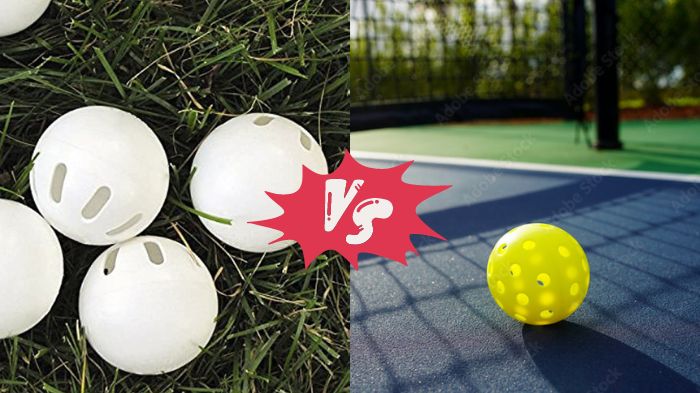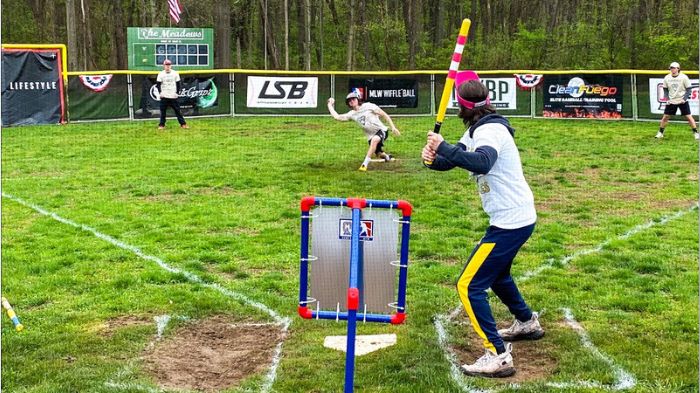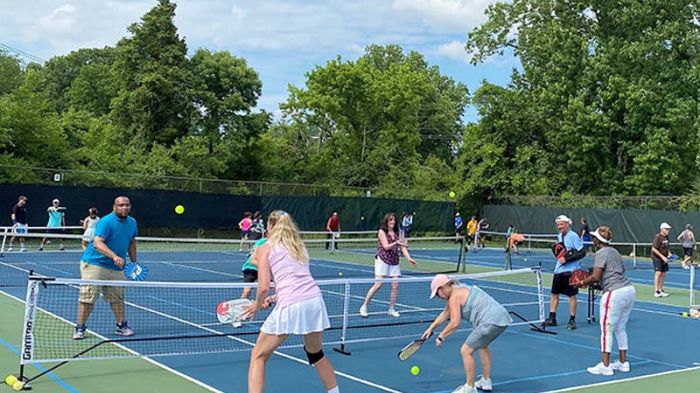Pickleball has seen significant growth in recent years, attracting players of all ages and skill levels. It offers a structured and strategic experience on a dedicated court, promoting competitive play and fostering vibrant communities. On the other hand, wiffle ball brings friends and families together for casual and creative gameplay.
With its nostalgic appeal and flexibility in playing locations, wiffle ball emphasizes pure enjoyment and fosters a sense of togetherness. Whether you prefer the structured nature of pickleball or the laid-back atmosphere of wiffleball, both sports offer unique experiences that are sure to bring fun and excitement to your outdoor activities.

Overview of Pickleball
Pickleball is a paddle sport that combines elements of tennis, badminton, and ping pong. It is typically played on a rectangular court, divided into a non-volley zone near the net. Players use solid paddles made of materials such as wood, composite, or graphite.
The game is played with a perforated plastic ball designed specifically for pickleball. With a focus on strategy, agility, and precision, pickleball offers an engaging and fast-paced gameplay experience. But, have you ever thought about what is pickleball ball made of? And why do you pop the pickleball up?
Overview of Wiffle Ball
Wiffle ball is a casual backyard game that emulates the feel of baseball. It is played with a lightweight, hollow plastic ball and a shorter plastic bat with perforations. Wiffle ball can be enjoyed in various settings, from improvised fields in backyards to organized tournaments.
The game allows players to showcase their hitting, fielding, and throwing skills while providing a nostalgic and enjoyable experience reminiscent of childhood games.
Comparison of Gameplay
Pickleball and wiffleball offer distinct and enjoyable gameplay experiences. Let’s take a closer look at each sport’s gameplay mechanics and unique characteristics.
Pickleball Gameplay
Pickleball is known for its fast-paced and strategic gameplay, combining elements of tennis, badminton, and ping pong. Here are the key aspects of pickleball gameplay:
Doubles Format: Pickleball is frequently played in the doubles format, which consists of two teams of two players each. This structure places a focus on partner collaboration, teamwork, and communication. In order to succeed at pickleball, cooperation is key.
Underhand Serve: With an underhand serve, the server attempts to clear the non-volley area close to the net to start the game. Players are not allowed to hit the ball out of the air in the non-volley zone, also referred to as the kitchen. Strategic shot placement and fair play are both protected by this rule.
Bounce Rule: After the serve, both teams must let the ball bounce once on their side before returning it. This rule adds an extra layer of strategy to the game as players must position themselves strategically and anticipate their opponent’s shots. It also allows for longer rallies and exciting exchanges.
Volley Rallies: Once the ball is in play, the objective is to engage in volley rallies, hitting the ball back and forth over the net. Players use their paddles to control the ball’s trajectory, aiming to outmaneuver their opponents and create scoring opportunities. Quick reflexes, agility, and shot placement are vital skills in these fast-paced exchanges.
Scoring Points: In pickleball, points can only be scored by the serving team. Each time a team wins a rally, they earn a point. The first team to reach 11 points, with a lead of at least two points, wins the game. This scoring system adds excitement and keeps the game competitive until the very end.
Wiffleball Gameplay
Wiffle ball offers a more casual and adaptable gameplay experience, reminiscent of backyard baseball. Here are the key aspects of wiffle ball gameplay:
Various Formats
Wiffle ball is a game that knows no limits when it comes to player count. Whether you’re a lone slugger, part of a dynamic duo, or part of a larger team, wiffle ball can adapt to accommodate any number of players. The game’s flexibility ensures that nobody is left on the sidelines.
Pitcher and Batter Dynamics
Picture this: the pitcher winds up, ready to unleash a wicked pitch, while the batter grips the bat with anticipation. It’s a battle of wits and skill as the pitcher strategically selects their pitch, aiming to baffle the batter and keep them swinging for the fences. With every pitch, tension builds, and the game becomes a thrilling duel between two competitors.
Fielding and Eliminating the Batter
As the batter connects with the ball, fielders position themselves strategically, like nimble ninjas ready to pounce. Their mission? To swiftly field the ball and eliminate the batter in a blur of precise throws and lightning-fast reflexes. It’s a display of athleticism and teamwork as fielders communicate, coordinate, and execute their mission to perfection.
Advancing Bases and Scoring Runs
After every successful hit, the batter transforms into a base runner and sprints resolutely toward the next base. In an effort to tag the runner out, the fielders race to make the ideal throw. In an effort to score that coveted run, runners slide, dive, and dodge tags as the action unfolds. Everyone is on their toes as they compete in a race against time and a speed and strategy duel.
Determining Game Duration:
In wiffle ball, time is of importance, but how long will the game last? The choice is up to the participants. Will they play a predetermined number of innings and keep everything in play until the last out? Or, in an effort to maximize each moment, will they put a time restriction, heightening the excitement? They have the option, which gives the game a sense of tension and suspense.
Understanding the distinct gameplay mechanics of pickleball and wiffleball allows players to choose the sport that aligns with their preferences, skill level, and desired level of competition.
Whether you enjoy the strategic and fast-paced nature of pickleball or the nostalgic and flexible atmosphere of wiffleball, both sports provide unique and enjoyable experiences for players of all ages.
Comparison of Court, Field, and Equipment
When it comes to the court/field and equipment, pickleball and wiffleball have their own distinct characteristics. Let’s explore the differences in detail:
| Pickleball | Wiffle Ball | |
|---|---|---|
| Court/Field | Dedicated court with specific dimensions | Varied playing area with defined boundaries |
| Court Dimensions | 20 ft wide, 44 ft long (doubles) | N/A |
| 20 ft wide, 20 ft long (singles) | ||
| Markings | Baselines, sidelines, non-volley zone | Boundaries defined by players |
| Non-Volley Zone | 7-foot area near the net | N/A |
| Equipment | Paddle made of wood, composite, or graphite | Lightweight plastic bat |
| Perforated plastic ball | Hollow plastic ball with perforations |
Pickleball Court
Dimensions: A pickleball court measures 20 feet wide and 44 feet long for doubles play, while for singles play, the width remains the same but the length is reduced to 20 feet.

Markings: A 36-inch-high net in the middle of the court divides it into two equal halves. The baseline, sidelines, and non-volley zone are some of its defined boundaries.
Non-Volley Zone: The kitchen, often referred to as the non-volley zone, is a 7-foot space on either side of the net. Except when the ball bounces, players are not permitted to enter this area and hit the ball out of the air.
Pickleball Equipment
Pickleball paddles are sturdy, rectangular-shaped rackets constructed out of lightweight materials like graphite, composite, or wood. They have a big hitting surface and a handle grip.
Pickleball uses a perforated plastic ball that is larger than a wiffle ball but somewhat smaller than a tennis ball. The ball’s holes aid in reducing its speed and enhancing flight stability.
Wiffle Ball Field
Playing Area: Wiffle ball can be played in various locations, such as backyards, parks, or improvised fields. The playing area can vary based on available space and player preferences.
Boundaries: Players define the boundaries of the field using markers, such as cones or chalk, to indicate the fair territory and outfield areas.
Bases: Bases can be improvised using objects like buckets, stakes, or mats. They are placed in strategic locations to represent first base, second base, third base, and home plate.
Wiffle ball gear, fourth
Bats: Wiffle ball bats are often made of lightweight plastic. In order to reduce weight and give the ball aerodynamic features, they have a thin barrel and perforations.
Balls: Wiffle balls are plastic balls with oblong openings that are hollow inside. It is harder for hitters to hit the ball because of these perforations since the ball travels with distinctive flight characteristics, such as curves and dips.
Community and Popularity
Both pickleball and wiffleball have grown significantly in popularity and have vibrant player cultures. Let’s explore the expanding appeal and sense of community that these sports have generated.
Pickleball’s Popularity and Community
Growing Popularity: Pickleball has experienced a surge in popularity in recent years. It has gained recognition as a fun, accessible, and inclusive sport suitable for players of all ages and skill levels.
Wide Player Base: The sport attracts a diverse range of participants, including young athletes, older adults, families, and even competitive athletes from other sports. This broad appeal contributes to the widespread popularity of pickleball.
Recreational and Social Activities: Pickleball serves as a recreational activity that promotes physical fitness and social interaction. Many players engage in casual matches, join local leagues, or participate in organized tournaments to test their skills and connect with fellow enthusiasts.
Organized Tournaments: The pickleball community organizes various tournaments at different levels, ranging from local events to national and international competitions. These tournaments create opportunities for players to showcase their abilities, compete with others, and build connections within the community.
Community Engagement: The pickleball community actively engages in sharing knowledge, organizing clinics and workshops, and fostering a welcoming environment for newcomers. Experienced players often mentor and guide beginners, fostering a supportive and inclusive community spirit.
Wiffle Ball’s Popularity and Community
- Nostalgic Appeal: Wiffle ball carries a sense of nostalgia, reminiscent of childhood games played in backyards or neighborhood parks. Its simplicity, adaptability, and emphasis on fun make it a popular choice for casual and recreational play.
- Social Gatherings: Wiffle ball often brings friends and families together for friendly competitions and enjoyable outdoor activities. It serves as a way to bond, share laughter, and create lasting memories.
- Community-Based Play: Wiffle ball is often played in local communities, where players organize impromptu games or join informal leagues. These grassroots initiatives foster a strong sense of community and provide opportunities for players to connect with others who share their passion for the game.

- Backyard Tradition: Many households have embraced wiffle ball as a beloved backyard tradition, hosting regular matches and tournaments. This fosters a sense of community within neighborhoods and encourages friendly rivalry among participants.
- Flexibility and Creativity: The casual nature of wiffle balls allows players to adapt the game to their surroundings, creating unique playing fields and rules. This encourages creativity and innovation within the community, fostering a spirit of shared enthusiasm and imagination.
Also Read About: Calling An Out Ball In Pickleball
Pros and Cons
| Aspect | Pickleball | Wiffle Ball |
|---|---|---|
| Accessibility | Suitable for all ages and skill levels | Suitable for all ages and skill levels |
| Social Aspect | Promotes social interaction and teamwork | Casual and fun, great for backyard games |
| Fitness | Improves cardiovascular health and coordination | Enhances hand-eye coordination and throwing |
| Availability | May have limited availability of dedicated courts | Can be played in various settings |
| Learning Curve | Easy to learn, but mastering techniques takes practice | Easy to learn, casual gameplay |
| Injury Risk | Low risk, but injuries can still occur | Generally safe, with minimal risk of injuries |
| Formal Structure | Established competitive structure | Limited formal competitive structure |
| Weather Impact | Can be played indoors and outdoors | Weather-dependent, outdoor gameplay |
| Equipment Options | Wide range of paddles and balls available | Limited equipment options specific to the sport |
Pickleball and wiffleball each have their own set of advantages and considerations. Pickleball’s structured gameplay and dedicated court provide a more formalized experience, promoting strategic play and competitive spirit.
Wiffle ball, on the other hand, offers a more casual and flexible approach, allowing for creative adaptations and an emphasis on pure enjoyment. Consider your preferences for gameplay style, level of competition, and social dynamics when choosing between the two.
Final Words
In conclusion, pickleball and wiffleball are two exciting sports that bring joy and entertainment to players of all ages. While pickleball offers a structured and strategic experience on a dedicated court, wiffleball provides a nostalgic and casual atmosphere in various playing locations.
Whether you prefer the fast-paced action of pickleball or the backyard fun of wiffleball, both sports offer unique experiences and opportunities to connect with others. So grab your paddle or bat, gather your friends and family, and dive into the world of pickleball or wiffleball for an unforgettable time of fun and friendly competition.



